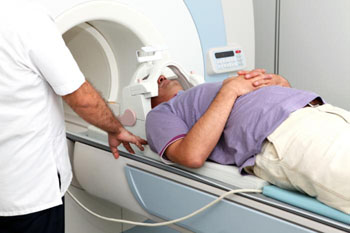BOLD MRI Can Detect Coronary Stenosis at Rest
By MedImaging International staff writers
Posted on 26 Jul 2016
A new study suggests that blood oxygen-level dependent (BOLD) magnetic resonance imaging (MRI) can detect myocardial ischemia without inducing cardiac physiological or pharmacological stress.Posted on 26 Jul 2016
Researchers at John Radcliffe Hospital (Oxford, United Kingdom) conducted a study to reevaluate data published in 2012 that focused more on segment-based analysis of BOLD, whereas the new analysis focused on whole-slice analysis. In the first study, which included 25 coronary artery disease (CAD) patients and 20 healthy volunteers, the researchers determined the diagnostic performance of stress BOLD imaging in identifying significant CAD.

Image: A patient about to undergo an MRI scan (Photo courtesy of MNT).
For the present analysis, resting BOLD signal intensity was first evaluated in the derivation group, and then tested in a separate validation group of 57 patients with suspected CAD referred for diagnostic coronary angiography. The range of BOLD signals at rest for each patient was indexed to create a score that correlated with presence of CAD, with an average index of 22.6% in those with versus 15.4% for those without ischemia. The researchers therefore defined a 16.1% cutoff score that identified ischemia-causing blockages.
Upon validation, the researchers found that the BOLD model could identify blockages with 88% sensitivity, 58% specificity, and 75% overall diagnostic accuracy. It performed similarly for diagnosing anatomically-significant CAD--defined as 50% or greater stenosis--at 82% sensitivity, 61% specificity, and 75% overall diagnostic accuracy. The researchers also concluded that BOLD MRI could perform equally well at stress as at rest. The study was published in the July 2016 issue of JACC: Cardiovascular Imaging.
“Our findings are pertinent to alternative imaging modalities with the potential to identify microvascular heterogeneity, and advance the concept of a functional assessment of CAD being performed at rest,” concluded lead author Jayant Ranjit Arnold, BMBCh, MA, and colleagues. “The inability of resting myocardial blood flow to discriminate the presence of CAD indicates that the favorable diagnostic performance of resting BOLD assessment is not dependent on changes in resting myocardial blood flow.”
BOLD MRI measures the blood oxygen level dependent signal that is associated with changes in blood flow and oxygenation following neural activity. The technique is particularly helpful in neurology for patients with premotor symptoms of Parkinson’s disease (PD) such as frontal executive dysfunction. The neuroimaging provides excellent resolution and diagnostic sensitivity, and can facilitate the diagnosis of other neurodegenerative conditions, including multiple system atrophy, corticobasal degeneration, and progressive supranuclear palsy.
Related Links:
John Radcliffe Hospital














